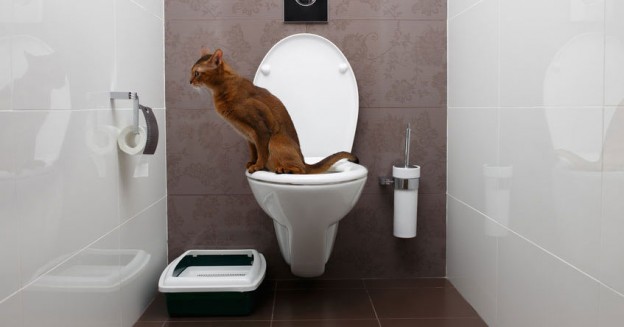We've come across the article pertaining to How to Dispose of Cat Poop and Litter Without Plastic Bags below on the internet and thought it made sense to talk about it with you on this page.

Introduction
As cat proprietors, it's important to bear in mind just how we dispose of our feline buddies' waste. While it might seem convenient to flush feline poop down the commode, this practice can have damaging effects for both the environment and human health and wellness.
Alternatives to Flushing
Luckily, there are more secure and more accountable means to dispose of feline poop. Take into consideration the adhering to alternatives:
1. Scoop and Dispose in Trash
The most typical technique of taking care of pet cat poop is to scoop it right into a biodegradable bag and throw it in the trash. Make sure to utilize a specialized clutter inside story and dispose of the waste quickly.
2. Use Biodegradable Litter
Select eco-friendly feline trash made from materials such as corn or wheat. These trashes are eco-friendly and can be securely thrown away in the garbage.
3. Hide in the Yard
If you have a backyard, take into consideration hiding pet cat waste in a marked area away from veggie gardens and water resources. Be sure to dig deep sufficient to stop contamination of groundwater.
4. Mount a Pet Waste Disposal System
Invest in a family pet garbage disposal system specifically developed for feline waste. These systems make use of enzymes to break down the waste, decreasing smell and environmental effect.
Wellness Risks
In addition to ecological issues, purging cat waste can likewise pose health dangers to people. Pet cat feces might contain Toxoplasma gondii, a parasite that can trigger toxoplasmosis-- a possibly extreme ailment, specifically for pregnant women and individuals with weakened immune systems.
Environmental Impact
Flushing cat poop introduces dangerous virus and bloodsuckers right into the water, posturing a significant risk to marine ecosystems. These contaminants can negatively influence aquatic life and concession water quality.
Conclusion
Liable pet possession expands past giving food and sanctuary-- it likewise includes appropriate waste management. By refraining from purging feline poop down the bathroom and choosing alternative disposal methods, we can decrease our ecological footprint and safeguard human health.
Why You Should NEVER Flush Cat Poop (and/or Litter) Down Your Toilet
The Problem with Litter
The main function of litter is to solidify and adhere to your cat’s waste. While this makes litter excellent for collecting cat poop and urine, it’s also the exact property that makes it a nightmare when flushed down the toilet.
Cat litter can and will clog pipes. There is non-clumping litter, but it’s still quite heavy and can build up in pipes. This is true even of supposed “flushable litter.”
The problems only compound when the litter is already clumped into cat waste. Toilet paper is among the more flushable things, and even too much of that will clog a toilet.
The Problem with Cat Poop
Sewers and septic systems are designed with human waste in mind. The microbes that help break down human waste don’t work on cat waste. Additionally, cat poop plays host to the parasite Toxoplasma gondii.
When flushed, this parasite can enter the environment in places it was never meant to, posing a risk to pregnant women, their unborn children, and other people with compromised immune systems. While it might not seem possible, flushing cat poop can indeed introduce this parasite to the public water supply.
These reasons are why, even if you’ve trained your cat to go on the toilet and flush, which is possible, it’s still not a good idea. Also, pregnant women and the immunocompromised shouldn’t change litter, either.
How to Handle Litter
The best way to handle litter is to simply put it in a plastic bag and place it in the trash. Avoiding environmental risks and possible plumbing damage is worth the extra effort.
You can also invest in devices that seal away your cat’s waste in a separate compartment, so you don’t have to change the litter nearly as often. They’re also safer for pet owners because they limit the possibility of Toxoplasma gondii exposure.
Disposing of litter the old-fashioned way will ensure you won’t have to worry about any issues that flushing the waste can potentially cause.
Take Care of Clogged Pipes with Stephens Plumbing, Heating & Air Conditioning
The reasons you should never flush cat poop down your toilet are numerous, but sometimes the inevitable happens despite your best efforts.
Stephens Plumbing, Heating & Air Conditioning is ready to help if you’re experiencing litter-blocked plumbing. Whether you need us in an emergency or want to schedule regular maintenance, we’re here for you.
https://www.stephensplumbing.net/bathroom-plumbing/never-flush-cat-poop-down-your-toilet/

I ran across that piece of writing on How to Dispose of Cat Poop and Litter Without Plastic Bags while doing a lookup on the internet. If you please set aside a second to distribute this content if you enjoyed it. Thanks a lot for your time. Kindly come visit our site back soon.
Book With Us Today!
Comments on “Prevent Plumbing Problems: Never Flush Cat Poop Down Your Toilet - Professional Guidance”